The ARM vs x86 Wars Have Begun: In-Depth Power Analysis of Atom, Krait & Cortex A15
by Anand Lal Shimpi on January 4, 2013 7:32 AM EST- Posted in
- Tablets
- Intel
- Samsung
- Arm
- Cortex A15
- Smartphones
- Mobile
- SoCs
Krait: Idle Power
We'll start out our power investigation looking at behavior at idle. Although battery life when you're actually using your device is very important, having a fast SoC that can quickly complete tasks and race to sleep means that you need to be able to drive down to very low idle power levels to actually benefit from that performance. Here we're looking at power consumption at the Start Screen in Windows RT/8. You'll notice that there are two distinct periods during the benchmark, with the latter part of the graph showing lower power consumption thanks to the live tiles going to sleep. In this test, WiFi is enabled but there's no background syncing of anything. WiFi being on is why we continue to see power spikes even after the live tiles have gone to sleep:
The W510 does a great job of drawing little power at idle. Its silly WiFi implementation results in peak idle power consumption that's very similar to the Dell XPS 10, but the lowest the platform hits is appreciably lower than anything else. Surface RT remains the more power hungry of the three, while the XPS 10 falls somewhere in between MS and Acer.
If we isolate CPU core power alone though, things are a bit different. Keep in mind that we don't have the L2 power island instrumented, so the XPS 10 looks a little better than it should here but minimum CPU power consumption is very good on Krait. Although the Atom Z2760 is built on a special SoC derivative of Intel's 32nm process, I do suspect that it's not quite as low power as TSMC's 28nm LP. Things may change by the time 22nm rolls around however. All meaningful compute transistors here should be power gated, and what we end up looking at is the best case leakage for all SoCs. The Krait/28nm LP combination is awesome. I'm not sure why Tegra 3 is so much more active here towards the very end of the curve by comparison.
Adreno 225, or at least whatever Qualcomm drives off of the GPU power rail is extremely power efficient at idle. The PowerVR SGX 545 curve looks flatter at the end but Qualcomm is able to hit lower minimum power levels. It's not clear to me how much of this is architecture vs. process technology. On the GPU side there is some activity happening here as the display is still being refreshed even though the system is idle, so we're not looking at purely power gated consumption here.
To take the WiFi controller out of the equation, I tossed all tablets into Airplane mode and re-ran the same tests as above. You'll notice much less fluctuation in power consumption once the live tiles go to sleep.
Take WiFi out of the equation and Acer's W510 looks really good. Intel worked very hard with Acer to ensure power consumption was as low as possible on this device. The XPS 10 does a bit better than Surface RT here, but not tremendously so. Acer/Intel hold the clear advantage.
Looking at the CPU power island alone (excluding the L2 cache for Krait), we continue to see lower idle power consumption from APQ8060A vs. Atom Z2760. Once again I believe this is a TSMC 28nm LP advantage more than an architectural thing.


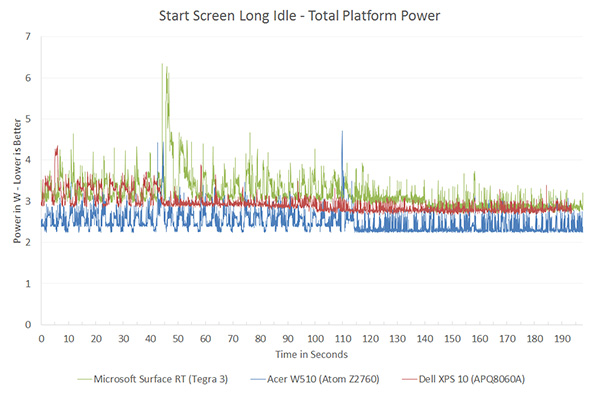
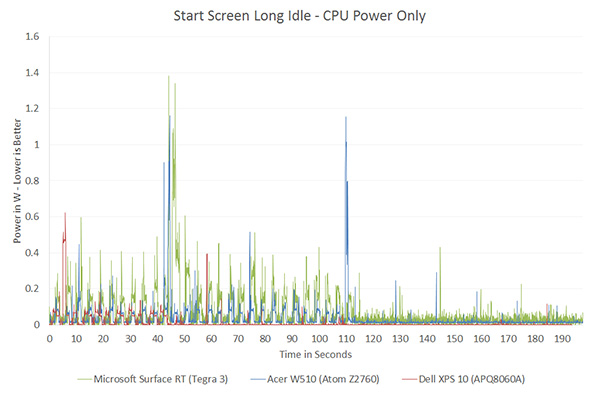
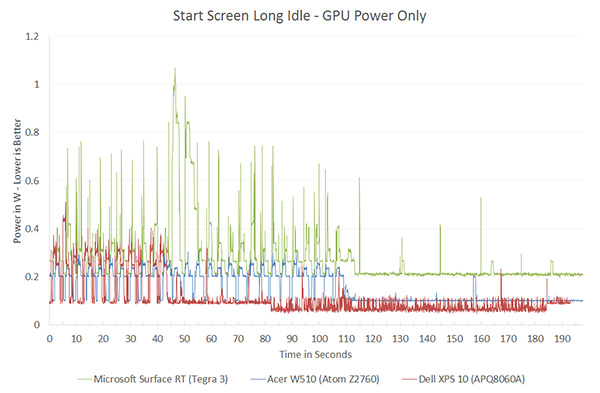
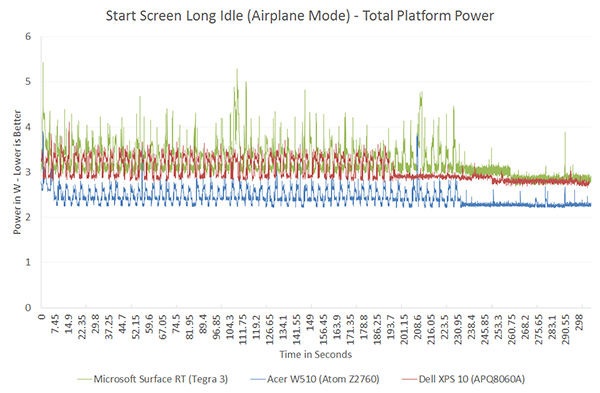
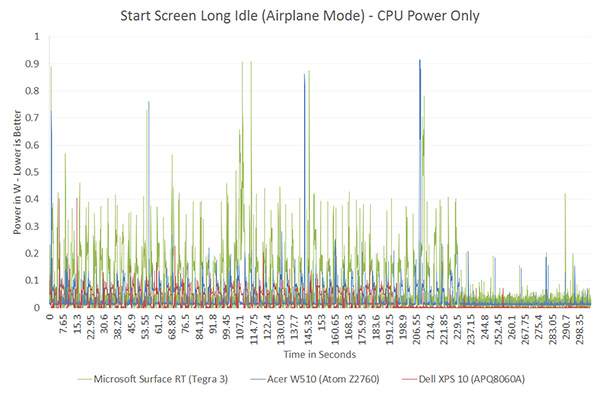
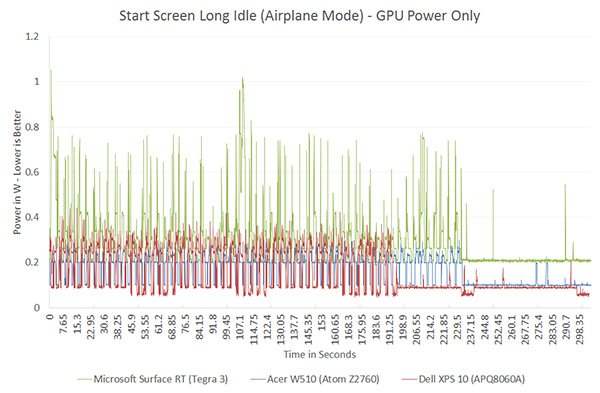








140 Comments
View All Comments
kumar0us - Friday, January 4, 2013 - link
My point was that for a CPU benchmark say Sunspider, the code generated by x86 compilers would be better than ARM compilers.Could better compilers available for x86 platform be a (partial) reason for faster performance of intel. Or compilers for ARM platform are mature and fast enough that this angle could be discarded?
iwod - Friday, January 4, 2013 - link
Yes, not just compiler but general optimization in software on x86. Which is giving some advantage on Intel's side. However with the recent surge of ARM platform and software running on it my ( wild ) guess is that this is less then 5% in the best case scenario. And it is only the worst case, or individual cases like SunSpider not running fully well.jwcalla - Friday, January 4, 2013 - link
Yes. And it was a breath of fresh air to see Anand mention that in the article.Look at, e.g., the difference in SunSpider benchmarks between the iPad and Nexus 10. Completely different compilers and completely different software. As the SunSpider website indicates, the benchmark is designed to compare browsers on the same system, not across different systems.
monstercameron - Friday, January 4, 2013 - link
it would be interesting to throw an amd system into the benchmarking, maybe the current z-01 or the upcoming z-60...silverblue - Friday, January 4, 2013 - link
AMD has thrown a hefty GPU on die, which, coupled with the 40nm process, isn't going to help with power consumption whatsoever. The FCH is also separate as opposed to being on-die, and AMD tablets seem to be thicker than the competition.AMD really needs Jaguar and its derivatives and now. A dual core model with a simple 40-shader GPU might be a competitive part, though I'm always hearing about the top-end models which really aren't aimed at this market. Perhaps AMD will use some common sense and go for small, volume parts over the larger, higher performance offerings, and actually get themselves into this market.
BenSkywalker - Friday, January 4, 2013 - link
There is an AMD design in their, Qualcomm's part.A D R E N O
R A D E O N
Not a coincidence, Qualcomm bought AMD's ultra portable division off from them for $65 million a few years back.
Anand- If this is supposed to be a CPU comparison, why go overboard with the terrible browser benchmarks? Based on numbers you have provided, Tegra 3 as a generic example is 100% faster under Android then WinRT depending on the bench you are running. If this was an article about how the OSs handle power tasks I would say that is reasonable, but given that you are presenting this as a processor architecture article I would think that you would want to use the OS that works best with each platform.
powerarmour - Friday, January 4, 2013 - link
Agreed, those browser benchmarks seem a pretty poor way to test general CPU performance, in fact browser benchmarks in general just test how optimized a particular browser is on a particular OS mainly.In fact I can beat most of those results with a lowly dual-A9 Galaxy Nexus smartphone running Android 4.2.1!
Pino - Friday, January 4, 2013 - link
I remember AMD having a dual core APU (Ontario) with a 9W TDP, on a 40nm process, back in 2010.They should invest on a SOC
kyuu - Friday, January 4, 2013 - link
That's what Temash is going to be. They just need to get it on the market and into products sooner rather than later.jemima puddle-duck - Friday, January 4, 2013 - link
Impressive though all this engineering is, in the real world what is the unique selling point for this? Normal people (not solipsistic geeks) don't care what's inside their phone, and the promise of their new phone being slighty faster than another phone is irrelevant. And for manufacturers, why ditch decades of ARM knowledge to lock yourself into one supplier. The only differentiator is cost, and I don't see Intel undercutting ARM any time soon.The only metric that matters is whether normal human beings get any value from it. This just seems like (indirect) marketing by Intel for a chip that has no raison d'etre. I'm hearing lots of "What" here, but no "Why". This is the analysis I'm interested in.
All that said, great article :)